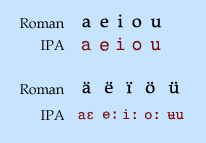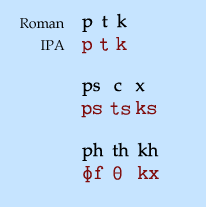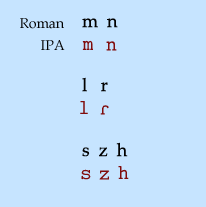![]()
![]()
Phonology - Garazedon
Vowels - Emëzanta
 Tháxata,
like many of the world's languages, has five basic vowels. They may be pronounced
either long or short.
Tháxata,
like many of the world's languages, has five basic vowels. They may be pronounced
either long or short.
Long vowels are indicated by an umlaut (ä).
Stress is normally on the penultimate syllable, but when it is not, it is marked with an acute accent (á).
Long vowels with irregular stress are marked with a circumflex (â).
Consonants - Moranta
The 19 consonants are divided into 7 series: three series of voiceless stops, a series of nasals, a series of smooth sounds, a series of rough sounds, and a series of voiceless stops. The first series consists of the three simple stops. The second has the three s-stops, where the stop is released with an s sound. The third series is the aspirate stop series, where the stops are pronounced with friction. The fourth series consists of sounds made with the nose. The fifth series has the two soft sounds. The sixth series has the three rough sounds that are made with friction. The seventh series has the three voiced counterparts of the simple voiceless stops.


pan two - tor noble - kaph fishhook
psen yellow - carpe fifty - xilia sky
pheiron signal - thena star - khör summer
mora consonant - niuza land
lizon eastern - rëtos blue
saita have - zan variety - hisän rain
banir castle - dësa eight - gelma town
Morphophonemics - Garazedia Halisec
Aspiration - Tholathor
If an affix makes it such that a simple voiceless stop is followed by a vowel, then the same stop, the first stop changes to the corresponding aspirate stop.
neciot + -'äta > necióthäta
sait + -etei > saithetei
Epenthesis - Kelagaradia
If an affix creates an illegal consonant cluster, an e is added at the morpheme boundary to prevent the cluster from occuring.
kaph + -ntun > kaphentun
<Back to the Introduction> <Forward to Morphology>
![]()
© 2003 J. J. Fatula, III, all rights reserved.